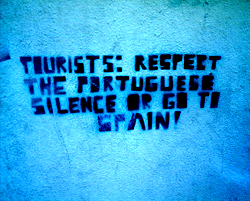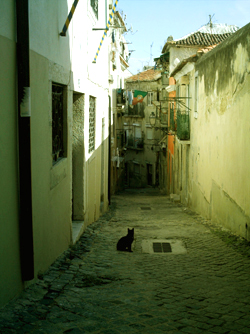 If you are visiting Lisbon then a walk around Alfama should definitely be on your must do list. Alfama is part of old Lisbon, the part that withstood the earthquake of 1755. The higgledy-piggeldy streets in this once no go area have in recent years opened up to the world and become a wonderful place to explore. Expect to get lost. It’s almost impossible to follow a map – let go and step back in time.
If you are visiting Lisbon then a walk around Alfama should definitely be on your must do list. Alfama is part of old Lisbon, the part that withstood the earthquake of 1755. The higgledy-piggeldy streets in this once no go area have in recent years opened up to the world and become a wonderful place to explore. Expect to get lost. It’s almost impossible to follow a map – let go and step back in time.
The tiny cobbled streets are mostly too small for cars, indeed you sometimes might want to breathe in when travelling on the tram through here! Steep hills and maze like streets wiggle their way down to the Tejo – these are known as travessas or becos instead of ruas. There are many sites to see here such as the Sé Cathedral, the Church of Saint Anthony (where St. Anthony was born), the Museum of Decoratives Arts, Lisbon Castle, the Puppet Museum, the Church of São Vincente de Fora, the Military Museum and the Museum of Water. A flea-market (Feira da Ladra) is held every Tuesday and Saturday morning and has much the same feeling as a Moroccan market – wonders hidden beneath trinkets and tat.
Personally I feel that the main attraction is the streets themselves. Steps from the Miradouro das Portas do Sol take you down into the area. A funny piece of graffiti requests that you to respect the silence: Alfama is a peaceful place. Often streets are deserted aside from a stray cat sitting in a patch of sunlight. On other streets, dogs bark or wag their tails from tiny balconies, children kick footballs, birds sing from cages dangling from windows and elderly ladies sit quietly in their doorways. On almost any street you are guaranteed to see the typical Lisbon site of washing hanging outside the windows and sometimes streamers from old festivals still decorate the streets.
Alfama is beautiful although I have to say the second time I visited there I was alone and felt a little more vulnerable. I did get very lost and had difficulty finding my way out. I spotted a rogue teenager who had a glint in his eye following me, so had to take different roads than the ones I thought I needed. In the end, fed up with the dance, I turned round and took his photograph – that seemed to put a stop to it!
Generally though, I would suggest if you are lost, just decide to make for up or down – you will eventually hit the water or end up back near the castle.
There are plenty of little bars, cafes and shops to sit in and enjoy the atmosphere. I particularly like the tiny fado bars on the edge of Alfama almost opposite the Fado museum. If you are keen on photography, Alfama offers some picture postcard scenes and plenty of atmospheric alleyways. Azulejos abound in the area and there are also parts that are extremely run down or derelict yet have fantastic graffiti. Under Arab occupation the area was known as al-hamma meaning spring or bath as hot springs are found here. However, as the Moorish rule fell, Alfama became an area where the poorer people lived. Fishermen often lived here with their families.
These days Alfama is a wonderful mix of old and new so typical of Lisbon in general. The ancient traditions are still evident in the ladies taking their washing to the public washing baths and the smoky fado bars yet you can find funky hip clubs and trendy bars down near the docks. Wandering in Alfama is perfect inspiration for the photographer, musician, novelist and film-maker alike.
Alfama is easy to find – just take the 28 tram to Miradouro das Portas do Sol (the stop after the castle). Alternatively you can get off at the castle and carry on walking up the hill past Miradouro de Santa Luzia. Look for the open air cafe to your right for the fantastic view. The steps down are just there.
There is an excellent collection of photos in the Alfama group on Flickr. Take a look here.




4 comments for “Alfama – Lisbon’s Oldest District”